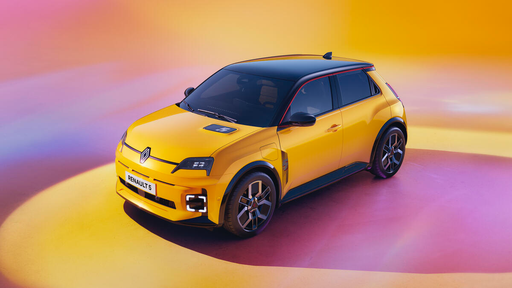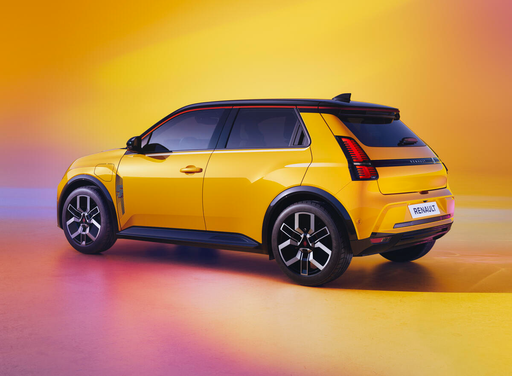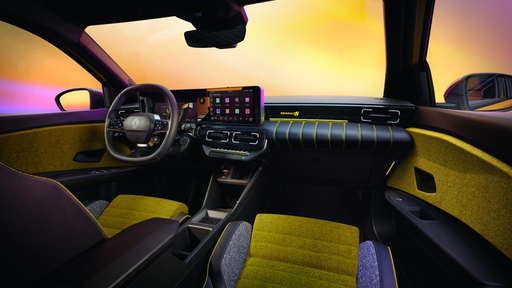Renault R5 vs Toyota Mirai – Differences & prices compared
Compare performance, boot space, consumption and price in one view.
Find out now: which car is the better choice for you – Renault R5 or Toyota Mirai?
The Renault R5 (Hatchback) comes with a Electric engine and Automatic transmission. In comparison, the Toyota Mirai (Sedan) features a Hydrogen engine with Automatic transmission.
When it comes to boot capacity, the Renault R5 offers 326 L, while the Toyota Mirai provides 300 L – depending on how much space you need. If you’re looking for more power, decide whether the 540 HP of the Renault R5 or the 182 HP of the Toyota Mirai suits your needs better.
In terms of consumption, the values are 14.80 kWh per 100 km for the Renault R5, and for the Toyota Mirai.
Price-wise, the Renault R5 starts at 23900 £, while the Toyota Mirai is available from 58700 £. Compare all the details and find out which model fits your lifestyle best!
Renault R5
The Renault R5 is a classic hatchback that captured the imagination of drivers with its distinctive design and compact versatility. Its agile handling and efficient performance made it a popular choice in urban settings and winding country roads alike. With a blend of style and practicality, the Renault R5 remains a beloved icon in automotive history.
details @ media.renault.at
@ media.renault.at
 @ media.renault.at
@ media.renault.at
 @ media.renault.at
@ media.renault.at
Toyota Mirai
The Toyota Mirai represents a groundbreaking step in hydrogen fuel cell technology, offering an eco-friendly alternative to traditional petrol engines. Its sleek design and futuristic aesthetic make it a standout on the road, while the interior combines comfort with cutting-edge features. With its impressive range and quick refuelling capabilities, the Mirai is paving the way for the future of sustainable motoring.
details @ Toyota
@ Toyota

|

|
|
|
|
Costs and Consumption |
|
|---|---|
|
Price
23900 - 132900 £
|
Price
58700 - 66700 £
|
|
Consumption L/100km
-
|
Consumption L/100km
-
|
|
Consumption kWh/100km
14.8 - 15.2 kWh
|
Consumption kWh/100km
-
|
|
Electric Range
307 - 405 km
|
Electric Range
650 km
|
|
Battery Capacity
40 - 52 kWh
|
Battery Capacity
-
|
|
co2
0 g/km
|
co2
-
|
|
Fuel tank capacity
-
|
Fuel tank capacity
5 L
|
Dimensions and Body |
|
|---|---|
|
Body Type
Hatchback
|
Body Type
Sedan
|
|
Seats
2 - 5
|
Seats
5
|
|
Doors
3 - 5
|
Doors
4
|
|
Curb weight
1447 - 1524 kg
|
Curb weight
1900 - 1930 kg
|
|
Trunk capacity
326 L
|
Trunk capacity
300 L
|
|
Length
3922 - 4080 mm
|
Length
4975 mm
|
|
Width
1744 - 2030 mm
|
Width
1885 mm
|
|
Height
1380 - 1498 mm
|
Height
1470 mm
|
|
Payload
396 - 418 kg
|
Payload
485 - 515 kg
|
Engine and Performance |
|
|---|---|
|
Engine Type
Electric
|
Engine Type
Hydrogen
|
|
Transmission
Automatic
|
Transmission
Automatic
|
|
Transmission Detail
Reduction Gearbox
|
Transmission Detail
-
|
|
Drive Type
Front-Wheel Drive, Rear-Wheel Drive
|
Drive Type
Rear-Wheel Drive
|
|
Power HP
122 - 540 HP
|
Power HP
182 HP
|
|
Acceleration 0-100km/h
3.5 - 9 s
|
Acceleration 0-100km/h
9.20 s
|
|
Max Speed
150 - 270 km/h
|
Max Speed
175 km/h
|
|
Torque
225 - 4800 Nm
|
Torque
300 Nm
|
|
Number of Cylinders
-
|
Number of Cylinders
-
|
|
Power kW
90 - 397 kW
|
Power kW
134 kW
|
|
Engine capacity
-
|
Engine capacity
-
|
General |
|
|---|---|
|
Model Year
2025 - 2027
|
Model Year
2021 - 2022
|
|
CO2 Efficiency Class
A
|
CO2 Efficiency Class
-
|
|
Brand
Renault
|
Brand
Toyota
|
Renault R5
The Renault R5: A Revolutionary Return
The iconic Renault R5 is back and it's more innovative than ever. The latest iterations of the R5 bring a fresh spin on the beloved classic, complete with cutting-edge technology and sustainable performance. Modernised for the contemporary driver, it retains its characteristic charm while integrating state-of-the-art electric capabilities.
Tech-Savvy and Environmentally Friendly
Gone are the days of petrol engines, as the new Renault R5 embraces a fully electric motor system. Available in two power variants, you can choose between a 95 PS or 150 PS output, catering to both urban commuters and those seeking a more spirited drive. With zero CO2 emissions, the R5 embodies Renault's commitment to sustainability and environmental responsibility.
Acceleration and Performance
The Renault R5 can accelerate from 0 to 100 km/h in just 8 seconds — an impressive feat for an electric hatchback. This agile performance is matched by a maximum speed of 150 km/h, ensuring that drivers won’t have to compromise on excitement and speed while adhering to eco-friendly practices.
Range and Efficiency
Featuring two battery options, the R5 offers varying ranges to suit different lifestyles. The Comfort Range sports a 52 kWh battery, promising up to 405 km on a single charge, while the Urban Range, with a 40 kWh battery, offers a respectable 300 km. These options provide flexibility depending on driving habits and needs.
Design and Practicality
Retaining its iconic hatchback silhouette, the Renault R5 measures 3,922 mm in length, 1,744 mm in width, and 1,498 mm in height. Its compact design is perfectly suited for urban environments, while the 326-litre boot ensures ample storage for everyday use. The five-door configuration provides easy access for passengers and cargo alike.
Cost and Value
Starting from €24,900, the Renault R5 offers exceptional value for an electric vehicle with its level of performance and technology. The range-topping models can go up to €34,400, with each variant providing an attractive balance of features and cost. Additionally, with multiple trim lines like "Iconic Five," "Techno," and "Five," there is a perfect R5 for every driver.
Conclusion: Driving the Future
With its striking blend of nostalgic design and futuristic technology, the Renault R5 is aptly poised to inspire a new generation of eco-conscious drivers. It's a testament to how classic designs can evolve without losing their soul, positioning the R5 not just as a car of the past, but a pioneer of tomorrow.
Toyota Mirai
The Future of Driving: Introducing the Toyota Mirai
The Toyota Mirai represents a significant leap forward in automotive innovation, being one of the leading vehicles in the hydrogen fuel cell market. As we continue to search for sustainable transportation solutions, the Mirai stands out with its pioneering technology and exceptional driving features.
Revolutionary Hydrogen Fuel Cell Technology
At the heart of the Toyota Mirai is its groundbreaking hydrogen fuel cell system. Unlike conventional internal combustion engines, the Mirai uses a fuel cell stack to generate electricity through the chemical reaction between hydrogen and oxygen. This process not only powers the car with zero emissions—producing only water vapour as a byproduct—but also delivers a smooth and silent drive.
Technical Specifications and Performance
The Toyota Mirai is designed with performance in mind. It boasts a power output of 182 PS (134 kW) and delivers a robust 300 Nm of torque, allowing it to accelerate from 0 to 100 km/h in just 9.2 seconds. While its top speed is a respectable 175 km/h, it's the Mirai's impressive range that really stands out. The vehicle can travel up to 650 km on a single hydrogen fill-up, making it a practical choice for long-distance travel.
Sophisticated Design and Comfort
Designed as a saloon, the Toyota Mirai combines aesthetic appeal with comfort. Its dimensions—4975 mm in length, 1885 mm in width, and 1470 mm in height—provide a spacious interior for five passengers. The design is sleek and modern, reflecting its advanced engineering. The boot offers 300 litres of storage, suitable for everyday needs.
Advanced Features and Safety
The Toyota Mirai doesn't just excel in propulsion technology; it also includes a range of advanced features to enhance driver comfort and safety. Available in three trims—Advanced, Executive, and Luxury—the Mirai includes state-of-the-art safety systems and infotainment options to ensure a connected and secure driving experience.
Cost and Efficiency
While the price of the Toyota Mirai ranges from €65,990 to €76,290, its monthly running costs—estimated between €1,496 and €1,672—and per kilometre costs of 59.9 to 66.9 cents, reflect the efficient nature of hydrogen-powered vehicles. Considering its innovative technology, the Toyota Mirai offers excellent value for those looking to invest in the future of eco-friendly transport.
The Toyota Mirai: Driving Towards a Sustainable Future
Overall, the Toyota Mirai is more than just a car; it's a vision for the future of sustainable transportation. With its cutting-edge hydrogen fuel cell technology, impressive range, and commitment to zero-emissions driving, the Mirai sets a new standard in environmentally conscious car design. Whether you're an eco-enthusiast or just someone seeking a reliable and technological advanced vehicle, the Toyota Mirai is worth considering.
The prices and data displayed are estimates based on German list prices and may vary by country. This information is not legally binding.
